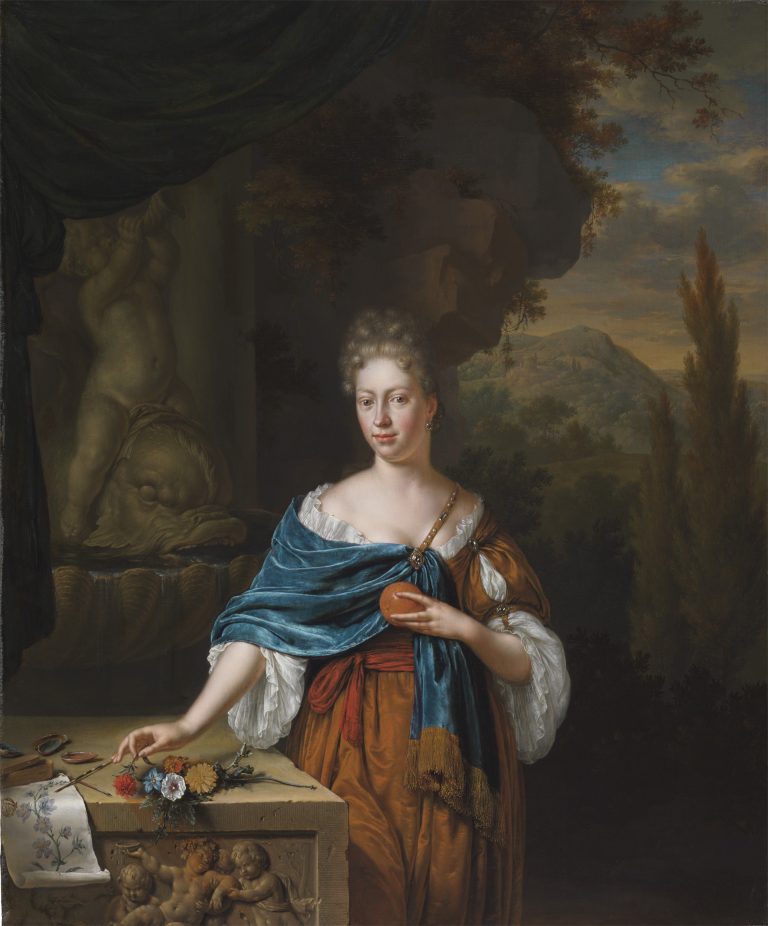Standing before an imaginary rocky landscape, a woman handsomely attired in an orange-tinged brown satin dress with an aqua-blue shawl draped across her body smiles charmingly out at the viewer. On the left, behind a partially drawn curtain and in front of a pillar, stands a fountain with a statue of a cupid riding a sea monster. The woman holds an orange in her left hand and carefully selects a red carnation from a bunch of flowers lying on a stone plinth faced with a carved relief sculpture of an unidentified allegorical subject.1 Resting on this garden plinth is a colored drawing of a flower, a small wooden box, some paintbrushes, and a couple of shells containing pigments.
The identification of the sitter is established by an eighteenth-century inscription written in Dutch on the back of the panel: “Dina Margareta de Bye, born on 7 May 1680 and deceased on 26 August 1740.”2 Dina Margareta was the second daughter of Johan Paeuw de Bye, a lawyer from Leiden, and his wife, Anna van Oorthoorn. In 1703 Dina Margareta married Pieter van der Dussen (1675–1726), also a lawyer, and moved from Leiden, where she apparently had been living with her parents on the Rapenburg, to her husband’s native city of Dordrecht.3 As Willem van Mieris already enjoyed a great reputation among the Leiden elite, he was a suitable choice to portray the esteemed Dina Margareta, even after she had moved to Dordrecht.
It was common for young, wealthy couples to commission pendant portraits upon the occasion of their marriage. Such “marriage portraits” (huwelijksportretten) would become important elements of their personal possessions.4 Although no documents list pendant portraits of the married couple, Dina Margareta’s inventory at her death in 1740 mentions a portrait of her husband and two portraits of her.5
The pictorial elements and date of this portrait two years after her marriage indicates that it was made within the marriage portrait tradition. Dina Margareta’s face and right arm are directed toward the left, that is, in the direction of her husband, assuming the traditional arrangement of pendant portraits. The setting and her attributes, moreover, embody virtues that were expected of a young wife in early modern Dutch society: purity, chastity, and love.6 The water from the fountain and the statue of cupid allude to love and purity, and the carnation she holds was a popular bridal flower.7 Oranges symbolize chastity and, hence, they were often depicted as an attribute for brides and married women. For example, in a portrait of Maria Timmers by Caspar Netscher (ca. 1639–84), the sitter gestures toward an orange branch along the basin of a fountain containing a statue of cupid (fig 1).8 Willem’s father, Frans van Mieris the Elder (1635–81), also depicted a woman holding an orange in his 1678 portrait of a married couple (Rijksmuseum, Amsterdam).9
Although it is highly probable that Van Mieris painted the male portrait at the same time, it is also possible that he created this portrait of Dina Margareta as a pendant to a preexisting portrait of Pieter van der Dussen, one perhaps even created by a different artist prior to the marriage.10 Van Mieris completed Dina Margareta’s portrait only in 1705, two years after her marriage, perhaps because she had a baby in 1704 and likely had no time to sit for a portrait.11
In preparation for his portrait, Van Mieris made a rough but precise preparatory drawing in black chalk, which fortunately is also in the Leiden Collection (fig 2) (WM-107).12 The drawing’s composition and other pictorial elements are mostly consistent with those of the painting, although he redirected Dina Margareta’s gaze so she looks out toward the viewer rather than to the left. He also shifted the direction of the sculpture of the cupid and sea monster in much the same manner, somewhat reinforcing the central focus of this image on Dina Margareta. The most significant alteration to the painting is the addition of the drawing, wooden box, paintbrushes, and shells on the stone plinth. As these are not typical attributes for a marriage portrait, the motifs can be considered personal attributes of this particular young woman. In those days, upper-class women often demonstrated their cultural and intellectual capabilities by drawing or painting. For example, in Arnold Boonen’s marriage portrait of Catharina Backer, who was likewise from a distinguished family on the Rapenburg, the young bride is depicted not only with flowers in a basket but also with a floral still-life painting on an easel (fig 3).13 Such objects probably were meant to convey the same message about Dina Margareta, who was portrayed as a virtuous woman with a taste for art.
